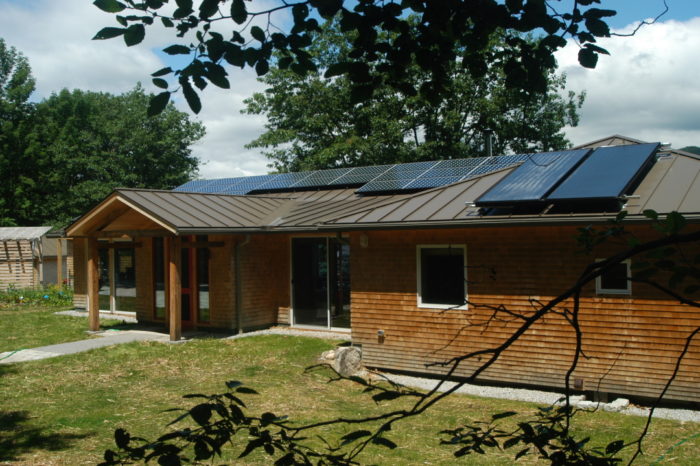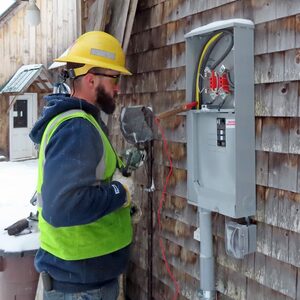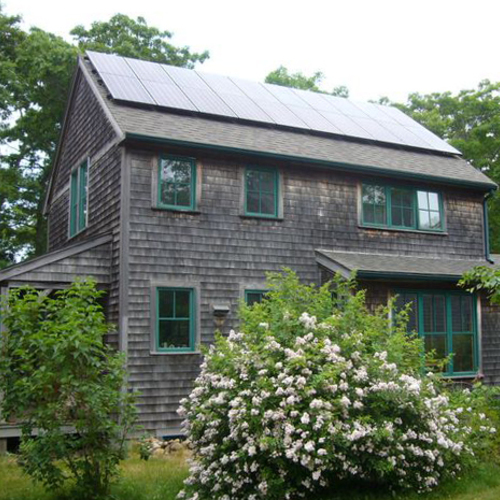
Image Credit: Scott Gibson
Most houses with solar electric panels remain grid-tied, meaning the house is still connected to the utility’s grid even as it has the means to produce its own power. Off-grid houses, which once accounted for the lion’s share of installations, are now in the minority.
And that seems to make sense. Grid-tied houses get the benefit of solar electricity, but also can tap into grid when panels don’t produce enough power to meet demand. Net metering allows houses to sell power at times when the panels are over-producing, and grid-tied systems are cheaper because they don’t require banks of deep-cycle batteries.
But is the situation really that cut and dried?
In a Q&A post at GreenBuildingAdvisor, Tristan Roberts says a chat with an expert at the Department of Energy got him poking at these widely accepted premises.
“If that electricity is feeding into the grid, we were discussing the difficulty in accounting for environmental benefits,” Roberts writes. “It’s hard to know if the 2 kW that you fed into the grid at 12 p.m. really resulted in the utility being able to reduce their coal-fired output by 2 kW. In fact, there are a lot of reasons to conclude that nothing of the kind happened…The point of our conversation was that the best use of on-site renewables, from a thermodynamic and environmental point of view, is on site.”
Does this mean, he wonders, whether homeowners should be steered more toward off-grid installations, or systems that split the electrical load between on-grid and grid-tied generation?
Yes, grid-tied systems make sense
While it’s unrealistic to think that small amounts of electricity fed into the grid will allow fossil fuel plants to be shut down, there are benefits nonetheless,…
Weekly Newsletter
Get building science and energy efficiency advice, plus special offers, in your inbox.

This article is only available to GBA Prime Members
Sign up for a free trial and get instant access to this article as well as GBA’s complete library of premium articles and construction details.
Start Free TrialAlready a member? Log in















14 Comments
TOU pricing reduces array size for net-zero?
I can't figure out that statement. Net-zero energy means you make as much energy as you use, in kWh. Whether you do that has nothing to do with the cost of the energy. Perhaps you meant a "net-zero-energy-cost house?"
Time og use electric pricing
The electric companies are doing what the airlines do, charge more during periods of high demand. If the value of the solar electricity is 28% higher (some utilities already charge far more than this in the afternoon) due to the time of day its being generated, then the size of the system to offset the electric bill to zero is smaller.
When enough homes generate much of their peak demand high value electricity, that plant that was built to generate the electricity only needed in the afternoon a few months out of the year isn't needed.
Yes, I get TOU pricing
But my point is, a $0 bill under TOU (and time-of-production) pricing does not a net-zero-energy home make. Net zero energy means you make as much energy as you use, in units of kWh, not dollars. :)
Why go net zero energy?
Eric, you're absolutely right.
The original article said, "During the sunniest times of the year, when a PV system is generating the most energy, the value of this energy in terms of retail price credits is much higher using a time-of-use electric rate schedule. This is a key reason why PV systems are financially attractive. This enables one to zero out the electric bill by installing a smaller system (about 28% smaller)"
Most net metering schemes drop the $/kwh reimbursement drastically once you cross the threshold of a zero electric bill. So the most cost effective scheme is to aim for net zero energy cost, not net zero energy.
No argument
I don't deny that net zero energy cost is a goal for some. Myself, I prefer both net zero energy use, and net negative energy cost ;)
Here in MN I had a chance to sign up for TOU with my net metering plan; now that I have a year's worth of data I should see if it would pay off faster. Although, I'm not sure I can change the contract at this point ...
TOU is worse than net metering
maybe some areas offer 'retail' level price credits for TOU excess energy generated, but that is far from the norm in the US
it is the reason that net metering is so valuable, you get a FULL credit for both your power and the line distribution charge at the electric companies billed rates.
if you got just a $ credit for the electricity you generated, the utility is not going to credit you for the line transmission charge as it is their line, and they generally pay you 'market rate' costs for the power, the same rates given to other power producers. those rates can be half what the utility bills you.
the utility may also tax and levee other utility charges on your usage that would not be offered as a refund when you sell power. sort of the issue you run into when you buy a product with a rebate; you pay taxes on the full purchase price.
also the late evenings tend to be high TOU pricing, the 5-9pm when many solar panels are not generating much if anything, and you'll be paying.
and you can get into situations like i'm in where the utility charges so much extra in fees for TOU and excess generation metering that you end up giving back all your gains. thats after you pay them for the privilege of approving your setup and buying/renting the metering equipment.
Xcel in MN
FWIW, Xcel in MN has this structure for Time of Day purchase: Roughly 4-4.5 cents on peak, 2.5 cents off peak. Compare that to Net Meter payments of 9-10 cents.
However, I have a hard time over-producing "net" at the end of the month, and I basically never get a payment. I certainly overproduce on most peak periods though, so in my case it might make sense, I dunno. Probably not worth the hassle.
TVA Areas
I looked into this a couple of years ago where I live, a TVA service area. At that time, you had to have 2 meters. One to sell, and one to buy, not to allow you to use your own power 'behind the scenes'. For a while TVA is paying $0.15/kwh for solar/wind generated, and selling it at $0.10/kwh for residential to a low of $0.05/kwh for high usage commercial. They said they were doing that till they got 10 to15% of total TVA production, or so I remember from a couple of years ago. Plus, you still have the local distribution company 'meter charge' of about $10/meter/month that isn't linked to power usage.
For green, I believe generating your own is the best. For $$ sense, purchasing makes the most sense.
In my 'perfect world', I think it would be good to generate your own power to cover your base load, and use 'purchased power' for peaking. If you have excess power being generated some times of the year, think of putting in some more batteries (within reason) or if you have a 'thermal mass' available, heat or cool it ahead of use as makes sense. ... Still no silver bullet, but
To Grid Tie or Not
I'm a builder and over the last three years I've pain stakingly build my own house (950 sqft) on evenings and weekends. I originally designed the house to be off-the-grid, but after much deliberation I've reconsidered the idea of being off-the-grid and I've decided to grid tied, due to the simplicity of backup systems. Also, I really don't like the idea of having my secondary and back up energy being any kind of liquid fuel. I know some fuels are better than others, but with all the money I've saved in simplifying my utilities I can now greatly increase the size of my PV array (3.5 Kw). I don't have to have a big fuel truck out to my house! My utility room now is so simple it's quit blissful and with all LED bulbs, Tier 3 Energy Star appliances, Ultra Low Flow shower and faucets, I should be near net zero in a 12 month cycle.
Way below net-zero has to be the goal today!
This is a great article and discussion. Based on our recent experience going way below net zero, I feel compelled to argue that net-zero is just not good enough any more. We use more energy running our cars than we do our homes, and at much higher cost, both in terms of pollution as well as money. Our Painted Hills house in Central Oregon is now producing enough energy not only to power itself, but to also power an electric vehicle. Based on the amount of surplus power this home produced during the first three months of operation (February through April), and based on the US EPA mileage estimates for electric cars, this house produced enough power to drive the car over 3,400 miles so far, and will provide over 12,000 miles of completely carbon-free living, with no net power bill for either the car or the house this year. This is where the big pay-off is for the use of PV power, especially with the grid available for storage. An energy model of our latest plan shows that the owner will save about $150,000 on energy over the thirty-year mortgage life on his home, but he would save over $292,000 on energy for his car, over what he would pay for gasoline for a 20 mpg vehicle at 18,000 miles per year for the same time period. We designed the house to provide that many miles of vehicle operation, based on the EPA estimates for a Nissan Leaf. Viva la grid!
Wholism
Building a net zero home and adding enough PV panels to an existing house to make it net zero are two different subjects. Any discussion of new construction without including passive heating and cooling seems incomplete to me.
And speaking of passive cooling, has anyone ever calculated the cooling relief provided by the shade that the solar cells cast on the roof?
Why not a little of each?
Couldn't one have a "somewhat" marginal off grid system where there would be limited battery storage capacity...say 12 hours worth....and when that capacity is full the system would switch over to grid-tie mode so that any excess energy would be sent to the grid. You wouldn't need as many batteries because you're only using limited amounts at night anyway. It also might take some tweaking to get your battery capacity and/or number of panels needed tuned in over the course of a year.
Response to Kenneth Sartain
Kenneth,
Batteries are expensive -- even enough batteries to run the average American house for 12 hours. Such a battery bank could easily cost $1,000 to $4,000. After 8 to 10 years, the batteries will need to be replaced.
If the idea is to have battery power for the rare power outage, that's a lot to invest. To handle occasional power outages, I suggest you invest in a gas-powered generator. It's cheaper.
reply to Brian Godfrey
"Building a net zero home and adding enough PV panels to an existing house to make it net zero are two different subjects. Any discussion of new construction without including passive heating and cooling seems incomplete to me."
Excellent point! One that is often missed by writers and others who do not understand how energy is used in buildings. It is an especially egregious omission by architects. Designers of large buildings trying to get LEED certification usually ignore the very basic premise of reducing building loads and add lots of cost and complexity in "efficient" mechanical systems and lighting controls.
"And speaking of passive cooling, has anyone ever calculated the cooling relief provided by the shade that the solar cells cast on the roof?"
Yes, this is a fairly simple calulation and has been done many times. The result, of course, is: "It depends." On most low-rise buildings, the roof is the largest component of solar heat gain. If dealing with that heat gain is a large component of the overall energy usage and if the PV array shades the entire roof, then the shading will have a significant effect. So far, I have three qualifiers in two sentences, and I've just scrathed the surface of the problem. Bottom line: There are less expensive ways to reduce solar heat gain through the roof, and a PV array's shade will most likely not be a significant difference in annual energy consumption.
Log in or become a member to post a comment.
Sign up Log in